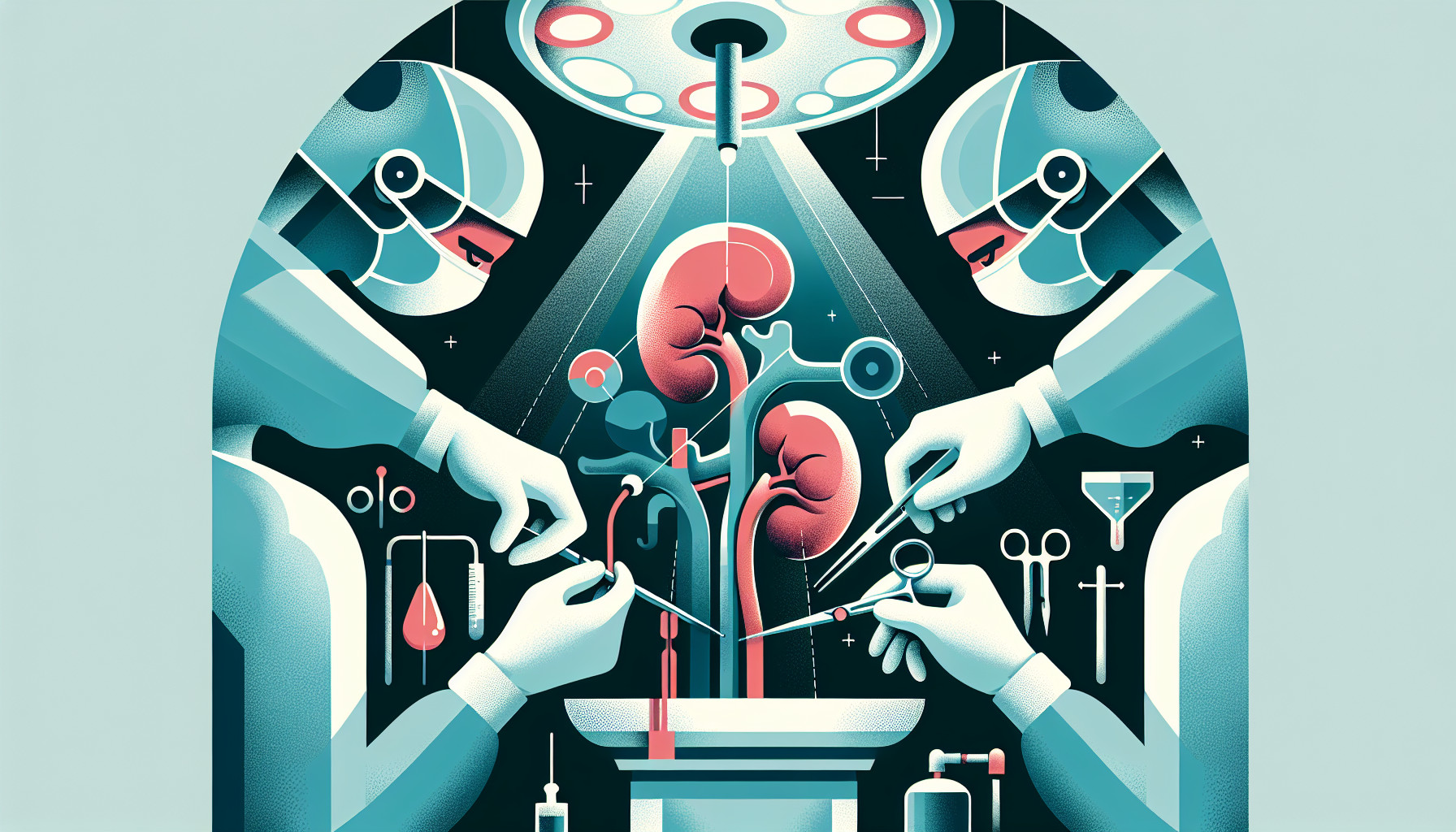Our Summary
This study looked at the safety of a procedure called laparoscopic donor nephrectomy (LDN), which is a minimally invasive method used to remove a kidney from a living donor for transplantation. This is important as there is a high demand for kidneys, and not enough are available from deceased donors. The safety of the living donor is of utmost importance, so this surgery should be performed by experienced surgeons.
The researchers looked at data from 200 people who donated kidneys and 200 who received them at a hospital in Ankara between 2016 and 2019. They compared information about the surgery, how long it took, how long the kidney was without blood supply (warm ischemia time), any complications, and how long the donors and recipients stayed in the hospital. They also looked at how long the recipients and the transplanted kidneys survived.
The researchers found that the procedure can be performed safely by a surgeon who has a lot of experience with laparoscopic surgery and open donor nephrectomy, a more traditional method of removing a kidney for transplantation. The results were comparable to other studies in terms of surgical time, complication rate, warm ischemia time, and survival rates for both the patients and the transplanted kidneys. The relationship between the donor and recipient did not affect the survival rates.
FAQs
- What is a laparoscopic donor nephrectomy (LDN)?
- How does the safety and effectiveness of LDN compare to traditional methods of kidney transplantation?
- Does the relationship between the donor and recipient affect the survival rates of the transplanted kidneys?
Doctor’s Tip
One helpful tip a doctor might give a patient undergoing laparoscopic nephrectomy is to follow all pre-operative instructions carefully, such as fasting before surgery and taking any prescribed medications. It is also important to discuss any concerns or questions with the surgical team beforehand to ensure a successful outcome. Additionally, following post-operative care instructions, such as taking pain medication as prescribed, getting plenty of rest, and avoiding heavy lifting, can help with a smooth recovery process.
Suitable For
Patients who are typically recommended for laparoscopic nephrectomy include those who are in need of a kidney transplant and have a living donor who is willing to donate a kidney. The living donor must be in good health and have compatible blood and tissue type with the recipient. Additionally, the donor must undergo a thorough evaluation to ensure they are a suitable candidate for surgery and can safely donate a kidney without compromising their own health.
Overall, laparoscopic nephrectomy is considered a safe and effective option for kidney donation, with comparable outcomes to open donor nephrectomy. It offers several advantages over traditional open surgery, including smaller incisions, less pain, shorter hospital stays, and quicker recovery times for both the donor and recipient. It is important for patients considering laparoscopic nephrectomy to discuss the risks and benefits with their healthcare team and ensure they are well-informed before making a decision.
Timeline
Before laparoscopic nephrectomy:
- The patient undergoes a thorough evaluation to determine if they are a suitable candidate for kidney donation.
- The patient meets with the surgical team to discuss the procedure, risks, and benefits.
- Pre-operative testing is done to ensure the patient is healthy enough for surgery.
- The patient is instructed on pre-operative preparations, such as fasting before surgery.
During laparoscopic nephrectomy:
- The patient is placed under general anesthesia.
- The surgeon makes small incisions in the abdomen to insert a laparoscope and other surgical instruments.
- The kidney is carefully dissected and removed from the body through one of the incisions.
- The incisions are closed, and the patient is taken to the recovery room.
After laparoscopic nephrectomy:
- The patient may experience pain and discomfort at the incision sites, which can be managed with pain medication.
- The patient will be monitored for any complications, such as bleeding or infection.
- The patient will be discharged from the hospital within a few days, depending on their recovery.
- The patient will have follow-up appointments with the surgical team to monitor their recovery and kidney function.
- The patient can resume normal activities, with some restrictions on heavy lifting and strenuous exercise for a few weeks.
What to Ask Your Doctor
Some questions a patient considering laparoscopic nephrectomy should ask their doctor include:
- How experienced are you in performing laparoscopic nephrectomy?
- What are the potential risks and complications associated with this procedure?
- How long will the surgery take and how long will I need to stay in the hospital?
- What is the warm ischemia time for the kidney during the procedure?
- How will my recovery process be after the surgery?
- What are the long-term effects of living with only one kidney?
- Will there be any restrictions or lifestyle changes I need to make after the surgery?
- What are the success rates for both the donor and the recipient after laparoscopic nephrectomy?
- How often will I need follow-up appointments after the surgery?
- Are there any alternative treatment options I should consider before proceeding with laparoscopic nephrectomy?
Reference
Authors: Sozener U. Journal: J Laparoendosc Adv Surg Tech A. 2021 Jun;31(6):627-631. doi: 10.1089/lap.2020.0545. Epub 2020 Jul 27. PMID: 32721258
